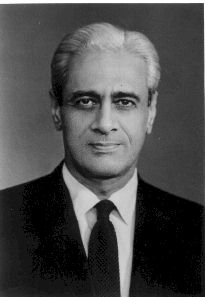| Satish Dhawan | |
|---|---|
 | |
| Born | 25 September 1920 Srinagar, Jammu and Kashmir,India |
| Died | 3 January 2002 (aged 81) India |
| Fields | Mechanical and aerospace Engineering |
| Institutions | Indian Space Research Organization Indian Institute of Science California Institute of Technology National Aerospace laboratories Indian Academy of Sciences and Indian Space Commission |
| Alma mater | University of Punjab (Pakistan) University of Minnesota California Institute of Technology |
| Doctoral advisor | Hans W. Liepmann |
| Known for | Indian space program |
| Notable awards | Padma Vibhushan |
Satish Dhawan (25 September 1920 – 3 January 2002) was an Indian aerospace engineer, widely regarded as father of experimental fluid dynamicsresearch in India. Born in Srinagar, Dhawan was educated in India and further on in the United States. Dhawan was one of the most eminent researchers in the field of turbulence and boundary layers, leading the successful and ingenious development of Indian space programme. He succeeded Vikram Sarabhai, the founder of the Indian space programme, as Chairman of the Indian Space Research Organisation (ISRO) in 1972.
Contents
[hide]Education[edit]
Dhawan was a graduate of University of the Punjab in Lahore, British India (now Pakistan), where he completed a Bachelor of Arts in mathematics andBachelor of Science in physics, followed by a Master of Arts in mathematics from the same institution. In 1943, moved to United States to further his education. He attended University of Minnesota, Minneapolis and completed a Bachelor of Engineering in mechanical engineering. In 1947, he completed a Master of Science in aerospace engineering and Aeronautical Engineer’s Degree from California Institute of Technology followed by a double PhD. in mathematics and aerospace engineering under the supervision of his advisor Dr. Hans W. Liepmann 1951.
Director, IISc (1962-1981) and Chairman, ISRO (1972-1984)[edit]
Prof Dhawan joined as faculty at the Indian Institute of Science (IISc), Bangalore in 1951 and became its Director in 1962. He also took over as Chairman of Space Commission and Chairman, Indian Space Research Organization (ISRO)and Secretary to the Government of India at the Department of Space.
Although he was the head of the Indian space programme, he devoted substantial efforts towards boundary layer research. His most important contributions are presented in the seminal book Boundary Layer Theory by Hermann Schlichting. He set up the country's first supersonic wind tunnelat IISc. He also pioneered research on relaminarization of separated boundary layer flows, three-dimensional boundary layers and trisonic flows.
Support of space research[edit]
Dhawan carried out pioneering experiments in rural education, remote sensing and satellite communications. His efforts led to operational systems like INSAT, a telecommunications satellite; IRS, the Indian Remote Sensing satellite; and the Polar Satellite Launch Vehicle (PSLV), that placed India in the league of space faring nations.
Honours[edit]
Following his death in 2002, the satellite launch centre at Sriharikota, Andhra Pradesh, located about 100 km north of Chennai in South India, was renamed the Satish Dhawan Space Centre.Satish Chandra Dhawan Govt. College , Ludhiana is named after him.
Career[edit]
- Indian Institute of Science, Bangalore
- Senior Scientific Officer, 1951
- Professor and Head of the Department of Aeronautical Engineering, 1955
- Director, 1962–1981[1]
- Visiting Professor, 1971–72
- National Aerospace Laboratories, Bangalore
- Chairman, Research council, 1984–93
- President, 1977–1979
- Chairman, 1972–1995
- Chairman, 1972–2002
Awards[edit]
- Padma Vibhushan (India's second highest civilian honour), 1981
- Indira Gandhi Award for National Integration, 1999
- Distinguished Alumnus Award, Indian Institute of Science
- Distinguished Alumnus Award, California Insititute of Technology, 1969
Family[edit]
His daughter Jyotsna Dhawan, is a renowned molecular biologist.
Works[edit]
- Dhawan S: Direct measurements of skin friction. Tech. Rep No.1121, National Advisory Committee for Aeronautics, Washington DC 1953.
- Schlichting H, Gersten K: Boundary Layer Theory (8th Revised & Enlarged Edition). Springer, 1999.
- Dhawan S: A glimpse of fluid mechanics research in Bangalore 25 years ago. India: Surveys in fluid mechanics Indian Academy of Sciences (Eds. R Narasimha, S M Deshpande) 1-15, 1982.
- Developments in Fluid Mechanics and Space Technology. (Eds. R Narasimha, APJ Abdul Kalam) Indian Academy of Sciences, 1988.
- Dhawan S: Bird flight. Indian Academy of Sciences, 1991.
- Dhawan S: Aeronautical Research in India. (22nd British Commonwealth Lecture). J. Royal Aero. Soc. 71, 149-184, 1967.
- Special Section on Instabilities, transitions and turbulence. (Ed. R Narasimha) Current Science, 79:725-883, 2000
Comments
Post a Comment